
Emission of geenhouse gases in 2010 across the DOWA group was 1,341,000 t (1,316,000 t in Japan and 26,000 t abroad), which was an increase of 12% compared to the previous year.
Accepted wastes, especially used oil and waste plastics, increased by 9% compared to the previous year in our environmental bussiness. CO2 emission derived from thermally treated accepted wastes increased to 504,000 t, which was an increase by 19% compared to the previous year. Although it is not easy to control reduction of CO2 emission on the accepting side of wastes, we endeavored to reduce CO2 emission by promoting thermal recycling through in-house power generation using heat from burning wastes or steam. In our environmental business, we achieved the increase of in-house power generation to 26GWh, an increase of 45% compared to the previous year.
In connection with recovery of economy in general, our production output of electric zinc products and ferrite powder products increased by 7% and 28% respectively compared to the previous year. As a result, CO2 emission increased to 670,000 t, 9% increase compared to the previous year. While we increased our production of goods, we also put in place measures to reduce CO2 emission including: switching from light oil to biodiesel fuel (BDF) at Okayama area, improving steam generation efficiency of roasting furnaces at Akita area and reduction of usage of heavy oil boilers by collecting steam from the sulfuric acid plant.
The business environment in Japan is still in an uncertain state due to the Great East Japan Earthquake and resulting shortage of electricity and materials. We continue to actively contribute to the environment by developing and offering eco-friendly products as well as putting in place our energy saving and greenhouse gas reduction measures.
Note: CO2 is calculated by multiplying grid purchased electiricity, purchased fossil fuel consumption and amount of accepted wastes by emission factor set forth in the Act on Promotion of Global Warming Countermeasures. However, CO2 emission derived from accepted wastes does not always correspond to the value submitted to administration authorities, as part of the prerequisites used in the method for this report differ from that for the reports to administration authorities. As segregation of wastes differs between Japan and other countries, it is difficult to set a proper emission factor to such emission. Therefore CO2 emission derived from wastes shown here are only from our business establishiments in Japan.< Derived from power generation + fuel >
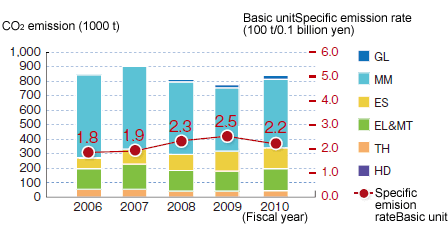
< Derived from wastes >
(Japan)
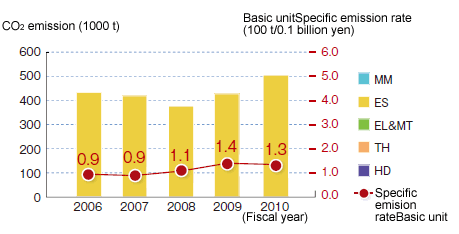
< Changes of Annual Emission of Greehouse Gases >
(Emission derived from wastes is only for business establishments in Japan)
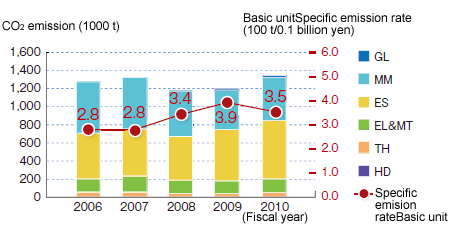
Other emissions (Greenhouse gas)
The CO2 emission derived from GHG in 2010 amounted to 23,400 kg–CO2. This was a result of use of 18 kg of HFC-134a. Although this amounted to only 0.002% of the entire GHG emission of the DOWA group, we further endeavor to reduce the amount in order to fight global warming.
 Reduction of Greehouse Gas Emission through the DOWA Group’s Business Activities
Reduction of Greehouse Gas Emission through the DOWA Group’s Business Activities
| Descriptions | Name of Products and Services | Goals Acheived in 2010 |
|---|---|---|
| Products and manufacturing business | Processed zinc products | 12.6% reduction of specific units of LPG emission compared to the previous year |
| Non-ferrous base metal (gold, silver, copper and lead) |
Improved operating effeciency of new furnaces and reduction of specific unit of energy consumption | |
| Collection of precious metals | Reduction of specific unit of energy consumption by 1.4% compared to the previous year | |
| Manufacturing of coper elongation products | Improved product yield by 1.2% | |
| Sales, cutting and processing of copper elongation products | Improved yield of sheet processing by 1% | |
| Sales, cutting and processing of copper elongation products | Reduction of power usage | |
| Sales, cutting and processing of copper elongation products | Collection of scrap from our customers | |
| Heat treated products | Reduction of specific unit of energy consumption by 14% | |
| Carbonized and TD processed products |
Reduction of specific unit of weight of city gases and electricity by 7% compared to 2009 | |
| Production of metal powder | Successful Continuous production of 3 batches by the α method | |
| Production of copper powder | Reduction of energy consumption by optimizing response time and drying time | |
| GaN-based HEMT epitaxial substrates | Mass production of large-diameter products | |
| Iron and carrier powder | Reduction of specific unit of energy consumption by 6% compared to 2009 |
| Descriptions | Name of Products and Services | Goals Acheived in 2010 |
|---|---|---|
| Environmental business (Japan) |
Wastes treatment | Power generation from wastes by operating incinerators |
| Overseas facilities | Processing of metal products | Reduction of specific unit of power consumption for manufacturing products (201 to 192 kWh/t) |
| Collection of gold and copper residues | Reduction of in-process city gas usage by 7% | |
| Wastes treatment | Increased collection of unused heat compared to the previous year |
Exhaust gas emission in 2010 was 9,203 million m3 (8,841 million m3 in Japan and 362 million m3 abroad) and the exhaust gas emission in Japan increased 18% compared to the previous year. Emission of nitrogen oxide in Japan increased by 8% compared to the previous year, as we accepted waste substrates in our environment business, while sulfur oxide and fly ash decreased 28% and 2% respectively compared to the previous year due to the decrease of heavy oil usage.
< Changes of Annual Exhaust >
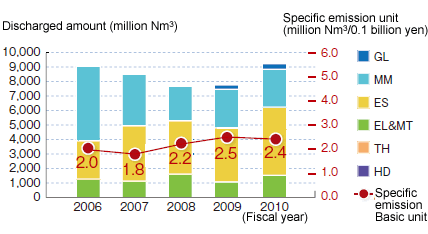
< Changes of Air Emission of per Substance >
(Products and manufacturing business)
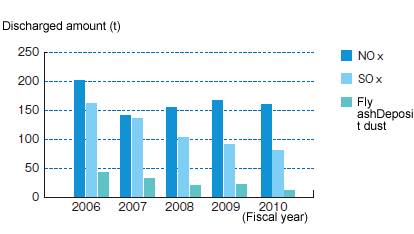
< Changes of Air Emission of per Substance >
(Environmental business in Japan)
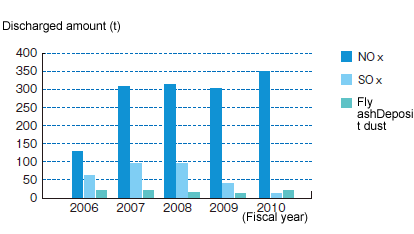
< Changes of Air Emission of per Substance >
(Overseas facilities)
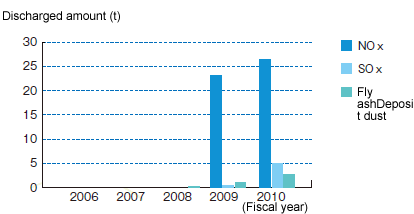
Quantity of waste water discharge in 2010 was about 97 million m3 (97 million m3 in Japan and 0.5 million m3 abroad). In connection with our efforts to reduce water usage in our smelting and refining business units that use most of water, the quantity of the waste water discharge decreased, resulting in the decrease of discharged water across the DOWA group by 5% compared to the previous year.
BOD (biochemical oxygen demand) and COD (chemical oxygen demand) in the discharged water in our environmental businesse in Japan decreased, while BOD and COD increased across the DOWA group by 3% and 7% respectively compared to the previous year as a reuslt of production increase in our products and manufacturing business.
< Changes of Annual Waste Water Discharge >
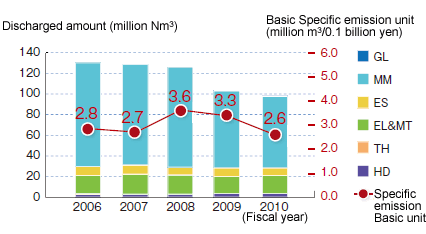
< Changes of Waste Water Discharge into Water Area per Substance >
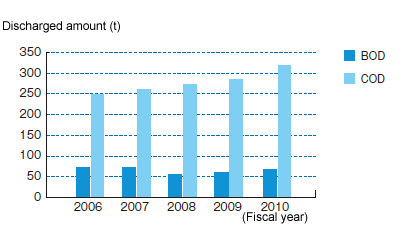
Wastes generated in 2010 were about 383,000 t (363,000 t in Japan and 14,000 t abroad). Wastes in Japan increased by 5% compared to the previous year. This was mainly due to increase of burnt residues in connection with the increase of incinerated wastes at Eco-System Chiba.
Wastes generated in our operating companies in Japan consist of 92% of industrial wastes and 8% of general wastes (business-related). Industrial wastes mainly consist of burnt residues (27%), slag (21%), sludge (26%), and ash (11%).
< Changes of Annual Production of Wastes >
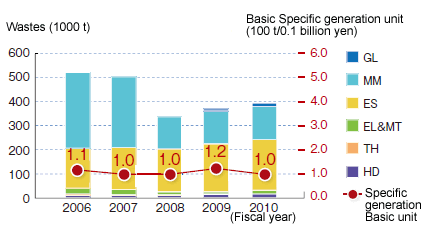
< Details of Disposed Wastes >
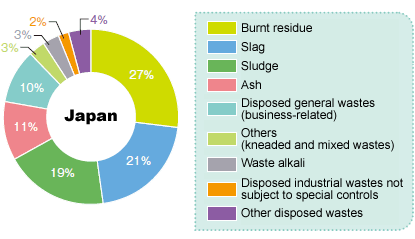
*As clasification of raw materials differs in Japan and outside Japan,
only those of business establishment in Japan are shown here.
 Reduction of landfill disposal through the DOWA Group’s Business Activities
Reduction of landfill disposal through the DOWA Group’s Business Activities
| Descriptions | Name of Products and Services | Goals Acheived in 2010 |
|---|---|---|
| Products and manufacturing business | Processed zinc products |
Reduction of slag production by 30% |
| Carrier powder | 177 ton reduction of sludge compared to 2009 | |
| Environmental business (Japan) |
Intermediate processing of ndustrial wastes | 175,520t of industrial wastes (including general wastes) was treated. |
| Treatment of residues of incombustible substances | Reduction of landfill disposal | |
| Melting and solidification processing of burnt ashes | Recycling of burnt ashes | |
| Sales of melted metal | Recycling of metals in burnt ashes | |
| Production and sales of aggregate | Recycling of burnt ashes | |
| Overseas facilities | Recycling of burnt residues | 1% of the total |
In 2010, volume of recycling amounted to 384,000 t (375,000 t in Japan and 9,000 t abroad). The volume in Japan decreased by about 13% compared to the previous year. This was due to the impact of the decrease soil recycling (32% decrease year-on-year). Recycling of gypsum (4% increase year-on-year) increased by 6% in our products and manufacturing business, while recycling of used home electric appliances increased in our environmental business in Japan.
Recycling consisted of recycling of materials (80%) and thermal recycling (20%). The materials recycled were mainly soil (48%), gypsum (26%), metals (13%). Thermal recycling consisted of shredded dust (49%), used oil (35%) and waste plastics (15%).
< Changes of Annual Recycling Amount >
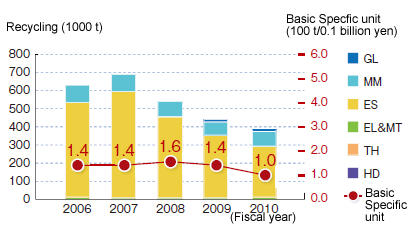
< Details of Recycling of Materials >
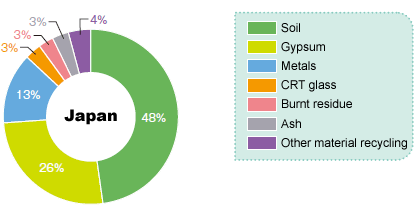
*As clasification of raw materials differs in Japan and outside Japan,
only those of business establishment in Japan are shown here.
 Our efforts to reduce packaging materials in 2010
Our efforts to reduce packaging materials in 2010
- We make every effort to reduce packaging materials through innovative packaging methods and reducing the number of individual packages through the use of larger containers.
- We make every effort to promote recycling of containers and packaging materials by utilizing used flexible containers and returnable containers.
- We encourage our vendors to collect containers and bring them back with them.
 Resource-recycling through the DOWA Group’s Business Activities
Resource-recycling through the DOWA Group’s Business Activities
| Descriptions | Name of Products and Services | Goals Acheived in 2010 |
|---|---|---|
| Products and manufacturing business | Rare metal (indium) | Increased recycled rare metals |
| Rare metal (gallium) | Increase | |
| Rare metal (bismuth) | Increase | |
| Nickel scrap use | Nickel scrap ratio of 15% | |
| Environmental business (Japan) |
Disposal of used home electrical appliances and office equipment | Recovered volume increased. |
The DOWA group is committed to fostering the forests in Kosaka area and making Akita Prefecture to be rich with biodiversity by afforestation to create and foster forests full of diversity. We planted 7,900 trees together with local people in 2010, under the leadership of the Japanese Center for International Studies in Ecology led by Honorary Professor Akira Miyawaki at Yokohama National University, who is the leading researcher in plant-ecology.
We will further discuss consider our boidiversity policy of the DOWA group.
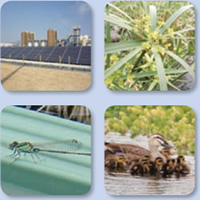 DOWA Hightech has effluent treatment facilities called “Bio Pallette,” where habitats for plants, aquatic creatures and micro-organisms are artificially created. The facilities clean water using its capacity for natural purification. The facilities can process approximately 2,500 tons of dischareged water per day, removing organic pollutants including BODs. Various creatures like dragonflies, their larvae and rice fish live in the Bio Pallete, and spotbill ducks catch them to raise their hatchlings. In this way the Bio Pallete contributes to biodiversity. We received Saitama Environment Award (12th) in 2010 for our environmental conservation efforts including cleaning activities of these facilities and Bizen Drainage Canel, into which the discharged water flows.
We newly installed solar panels with 8kw of capasity in August 2010 for use in our own facilities, contributing to countermeasures against global warming. We consider increasing our facilities and use them for environmental education of local people and as a place of social exchanges.
DOWA Hightech has effluent treatment facilities called “Bio Pallette,” where habitats for plants, aquatic creatures and micro-organisms are artificially created. The facilities clean water using its capacity for natural purification. The facilities can process approximately 2,500 tons of dischareged water per day, removing organic pollutants including BODs. Various creatures like dragonflies, their larvae and rice fish live in the Bio Pallete, and spotbill ducks catch them to raise their hatchlings. In this way the Bio Pallete contributes to biodiversity. We received Saitama Environment Award (12th) in 2010 for our environmental conservation efforts including cleaning activities of these facilities and Bizen Drainage Canel, into which the discharged water flows.
We newly installed solar panels with 8kw of capasity in August 2010 for use in our own facilities, contributing to countermeasures against global warming. We consider increasing our facilities and use them for environmental education of local people and as a place of social exchanges.
We endeavor to reduce disposal of substances targeted by the PRTR (Pollutant Release and Transfer Register) law in each of our plants, by improving life cycle of chemicals and promoting their recycling.
Unit: t (g-TEQ for dioxine)
| Cabinet order no. | Name of Class I chemical substances | Discharged amount | Transferred amount | ||||
|---|---|---|---|---|---|---|---|
| Atmosphere | Water area | Soil | Landfill within our own property | Sewage system | Outside of each operating company | ||
| 1 | Water-soluble compounds of zinc | - | 5.3 | - | - | - | - |
| 31 | Antimony and its compounds | 0.018 | 0.39 | - | 110 | - | - |
| 43 | (No. before revision) Ethylene glycol | - | 0.12 | - | - | - | 3.5 |
| 53 | Ethyl benzene | 0.030 | - | - | - | - | 3.0 |
| 75 | Cadmium and its compounds | 0.02 | 0.09 | - | 110 | - | - |
| 80 | Xylene | 0.03 | - | - | - | - | 3.2 |
| 82 | Silver and its water-soluble compounds | 0.01 | - | - | 5.3 | - | 0.01 |
| 87 | Chrome and trivalent chrome compound | - | 0.06 | - | 180 | - | 1.8 |
| 132 | Cobalt and its compounds | - | - | - | - | - | 2.5 |
| 144 | Inorganic cyanogen compounds (excluding complex salt and cyanic acid) | - | - | - | - | - | 0.01 |
| 237 | Marcury and its compounds | - | - | - | 0.61 | - | - |
| 242 | Selenium and its compounds | 0.019 | 0.2 | - | 6.9 | - | - |
| 243 | Dioxine | 0.14 | - | - | - | - | 28 |
| 258 | 1, 3, 5 and 7 – tetraazatricyclo [3.3.1.1.(3, 7)] decane | - | 0.08 | - | - | - | 766 |
| 272 | Water-soluble salt of copper (excluding comples salt) | - | 0.95 | - | - | - | 6.4 |
| 304 | Lead | 0.24 | 0.08 | - | 1400 | - | 91 |
| 308 | Nickle | - | 0.01 | - | - | - | - |
| 309 | Nickle compounds | - | - | - | - | - | - |
| 332 | Arsenic and its inorganic compounds | 0.02 | 0.07 | - | 870 | - | 3.2 |
| 333 | Hydrazine | - | - | - | - | - | 3.0 |
| 374 | Hydrogen fluoride and its water-soluble salt | 1.5 | 34 | - | - | - | - |
| 405 | Boron compounds | - | 11 | - | - | - | - |
| 412 | Manganese and its compounds | - | 7.3 | - | - | - | 600 |
 Reduction of Discharged Chemical Substances through the DOWA Group’s Business Activities
Reduction of Discharged Chemical Substances through the DOWA Group’s Business Activities
| Descriptions | Name of Products and Services | Goals Acheived in 2010 |
|---|---|---|
| Products and manufacturing business | Zinc wire, powder | 4.6% reduction of specific units of discharge of zinc wire, powder and used oil compared to 2009 |
| Manufacturing of copper elongation products | Smoke emission measures for molten casting facilities were enhanced. | |
| Cadmium-free products | Cadmium in products was reduced to 75 ppm or less. | |
| Lead-free products | Lead in products was reduced to 0.1% or less. | |
| Manufacturing of ferrite powder | The amount of bithmuth used decreased. |



